CentroConsult - Research in Slovakia and former Austria-Hungary
Land register in Slovakia
Section 2 - advanced

Purpose of this page
In this section we present also more detailed description of the
land record systems in Slovakia in last 100 years, examples of
real historical and present documents and hints how Slovak
expatriates can claim their land possessions in Slovakia.Table of contents
- Land register before circa 1960
- Land register after circa 1960
- Recovery of the land register
- Examples of the property sheets
- How to submit a land claim in Slovakia
- Press monitor
Land register before circa 1960
In Hungary and later in Czechoslovakia the small land owners rarely wrote a Will. According the Hungarian law the property was split into equal shares amongst the children (In Austria including the Czech lands usually the oldest son inherited the land, therefore the land ownership there is not so diluted as in Slovakia). After two generations it becomes impossible to split the parcels in kind (i.e. to create more but smaller parcels), therefore the parcel was fixed, but the number of owners was increased. The property share was distributed usually uniformly between the heirs. Therefore in Slovakia most of the land is in a JOINT OWNERSHIP.In Hungary there was a land record system called "telekkönyv" (pozemková kniha). It was actually a collection of files, each file had name "telekkönyvi betét (TB)". The Slovak expression is "pozemkovo kniná vloka" (PKV). Let us use the Slovak acronym PKV in what follows.
Each PKV file consisted of three parts:
- Part A - description of the property and inventory of the parcels;
- Part B - owners and changes of ownership in chronological order;
- Part C - liabilities (if any);
Part A - description of the property and inventory of the parcels
| The original Hungarian
name was A) Birtoklap (in Slovak A) Majetková
podstata) If the numbering of the parcels was consecutive, they were probably adjacent, if the there was a gap in numbering, the parcels were probably not adjacent. An example of a PKV #40 from the village Mliečno (now part of amorín) is presented on the right. There were two parcels # 734/2 and 735/2. Click on it to enlarge it. |
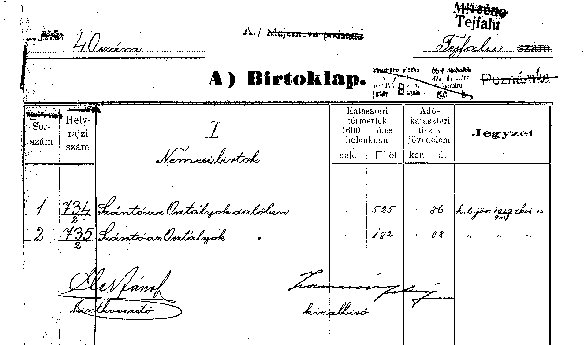 |
Part B - owners and changes of ownership in chronological order
| The original Hungarian
name was "B) Tulajdoni lap" (in Slovak B) Vlastníctvo).
We present again an example. The whole first page is
available after clicking on
the truncated page on the right. There are listed
the owners and the ownership changes in the
chronological order. The first and second records state, that in 1895 Gyorgy Csiba and his wife Veron Tóth purchased both a fraction of the property described in the part A). They acquired an arithmetic fraction of 1/6 "egy hatod részben". The third record states, that Menyhert Zolderdo purchased the fraction 4/6 (négy hatod részben) in 1897. The two parcels were thus between 1897-1923 in joint property of three individuals with following shares:
The couple Gyorgy Csiba and Veron Csiba nee Toth had 8 children, among them one daughter Maria Saghy nee Csiba who died in 1910 leaving 5 children from her first marriage and one child from the second. In 1923 Veron Toth died, her heirs were the 7 living children and 6 grandchildren (children of late Maria). The 1/6 share of the deceased was divided uniformly to 8 parts, it corresponded to fraction 1/48, further the fraction to be assigned to the late Maria was divided to 6 parts uniformly to all her six children, this corresponds to an fraction of 1/288. The ownership to the two parcels was finally as follows:
You see, the notary public were skilled mathematicians. The total arithmetic sum of all shares is always 1.00. |
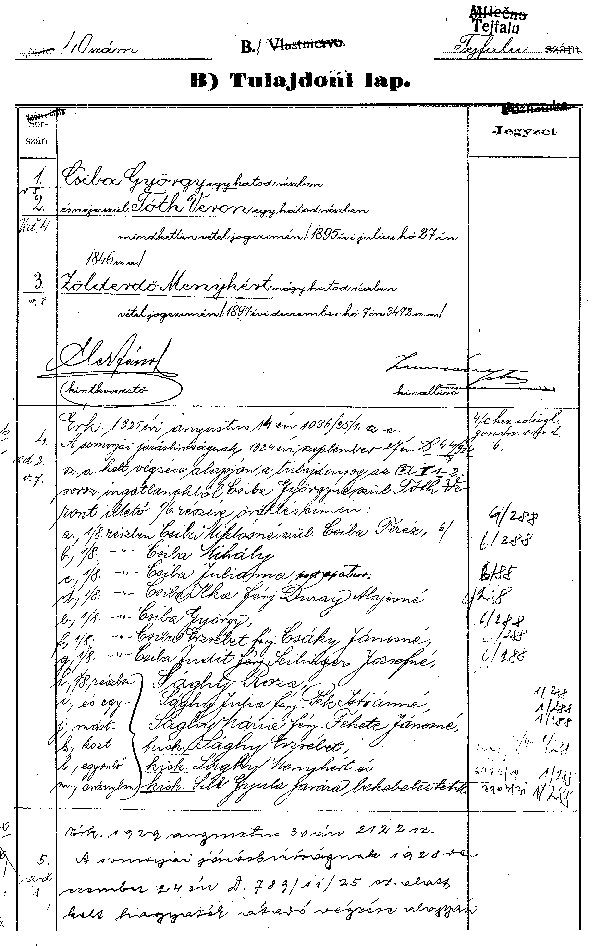 |
This process was continued resulting in the present diluted joint property. According an article in the Slovak Spectator, the average land in rural areas covers 0.45 hectares and belongs to 12 to 15 co-owners
Part C - liabilities (if any)
In this part the liabilities and debts were recorded.This system established end of 19th century was in operation until circa 1960, when a new modern system was introduced. The system survived changes of state borders, changes of political regimes and nationalization.
Agricultural cooperatives
The majority of the land owned by Hungarian aristocracy was
nationalized before W.W.II. The Czechoslovak communist regime
did not nationalize the land of small farmers, therefore only
the property of "big landowners" was nationalized by the
communists. The Czechoslovak communist adopted another
agricultural policy as in Soviet Union. The small farmers were
invited to join the cooperatives and many of them joined
voluntarily, others were forced to join. This was called
"kolektivizacia" The "agricultural cooperatives" were indeed
"cooperatives" which cultivated the plots of their members. It
is not known in the West, that the land alone was not
nationalized! This means, that even during communist regime the
land was in private ownership "de jure", but the owners had no
possibility to withdraw their plots and to cultivate them alone.
The ownership of the houses and adjacent gardens and even small
acreage (called as "zahumienky") was not tackled by the
communist regime at all.It must be noted, that there were villages, where despite the massive state campaign the farmers resisted and did not establish a cooperative - such farmers remained private farmers also during communist regime.
Land register after circa 1960
In about 1960 a new land register system was created. The new
system conserved the old registers and parcels based on PKVs and
in addition a new system based recording not only the ownership,
but also the "users". This was very important for the
cooperatives, where the land was still in ownership of the
individuals (cooperative founders), but cultivated (utilized) by
a legal entity - cooperative. Later the younger generation has
forgotten about the possessions of their ancestors and the state
did not encourage the heirs to claim their estate which was
utilized by cooperatives. This schizophrenic system caused, that
many former owners and their descendants are still thinking,
that their land was nationalized in early 1950, but it is not
true!Recovery of the land register
After the revolution in 1989 the recovery of the land register got one of the priorities of the government. In 1995 a law was passed with intention to complete the renewed register of land (ROEP, register obnovenej evidencie pody) in 2005. During the period 1995-2005 the screening of the land ownership had to be completed. In each town there are local land register recovery committees searching for the owners. There are many land records, which were not updated in last 100 years, but the most owners were "lost" in the period 1939-1989.The two main reasons, why the owners get unknown are:
- In the first half of the 20th century there was a massive emigration from Slovakia. Most of the emigrants left small shares of joint land ownership in Slovakia. When this first generation of the emigrants died, the heirs abroad did not record the death of the deceased to the authorities in Slovakia. Thus the owners who died abroad many years before are still recorded as the owners. During W.W.II and during the communist regime it was also practically impossible to settle an estate in Slovakia for the expatriate heirs.
- After circa 1950 most agricultural land and forests were cultivated by the cooperatives and state enterprises. Many people believed that their property was nationalized, even it was not (see above). In the case of an owner who died, the heirs in Slovakia simply did not claim the estate, which was in their eyes already "nationalized".
- The unclaimed land is to be nationalized and then utilized by the state;
- The unclaimed land will be first nationalized and then
transferred to ownership of municipalities.
This recovery process is supervised and managed by the Slovak Office for Cartography and Land Registry (Úrad geodézia a katastra SR).
There is a possibility to download the Property sheets (List vlastníctva, LV) (.pdf file) and to print the cadastre maps using the online Katastrálny portál.
The modern land records have the same structure, as the records before 1948. Of course they are digitized. The legal hard copy document attesting ownership is called Vypis z listu vlastnictva (Extract from the property sheet), in bureaucratic jargon called simply List vlastnictva, the acronym is LV. The structure is the same as in the Pozemkovo kniná vloka( PKV) described above.
- Part A - description of the property and inventory of the parcels;
- Part B - present owners only, there is no history of the ownership recorded any more;
- Part C - liabilities (if any);
Examples of property sheets
Here is an example of a "List vlastníctva", where VÁCZY Ján. This is a LV c. 760 listing only one parcel, total two pages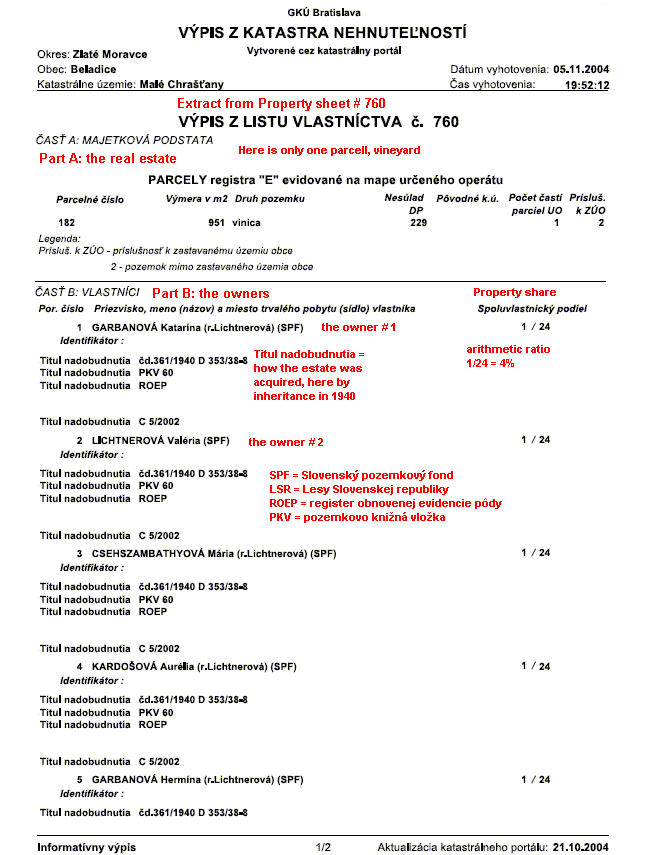
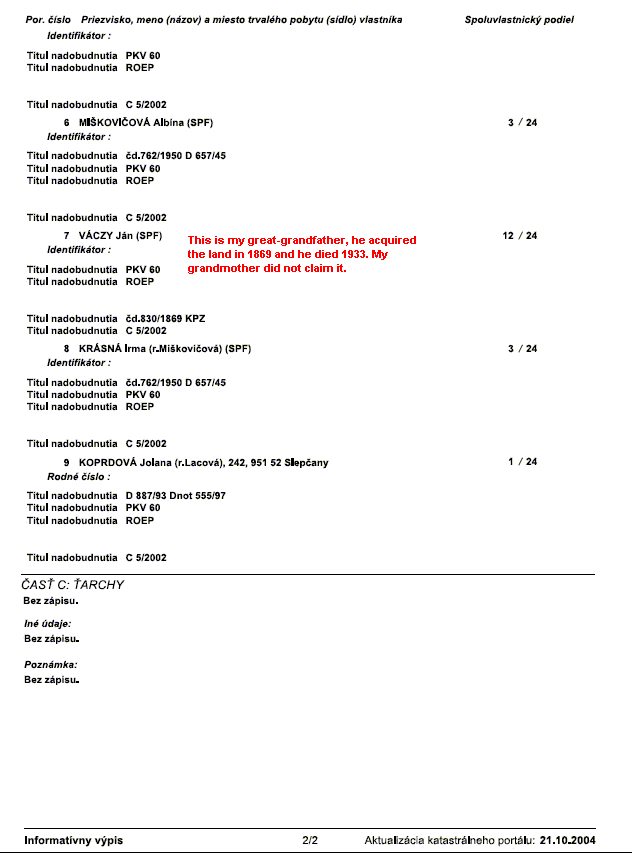
Next example is LV c. 1883 which lists three parcels.
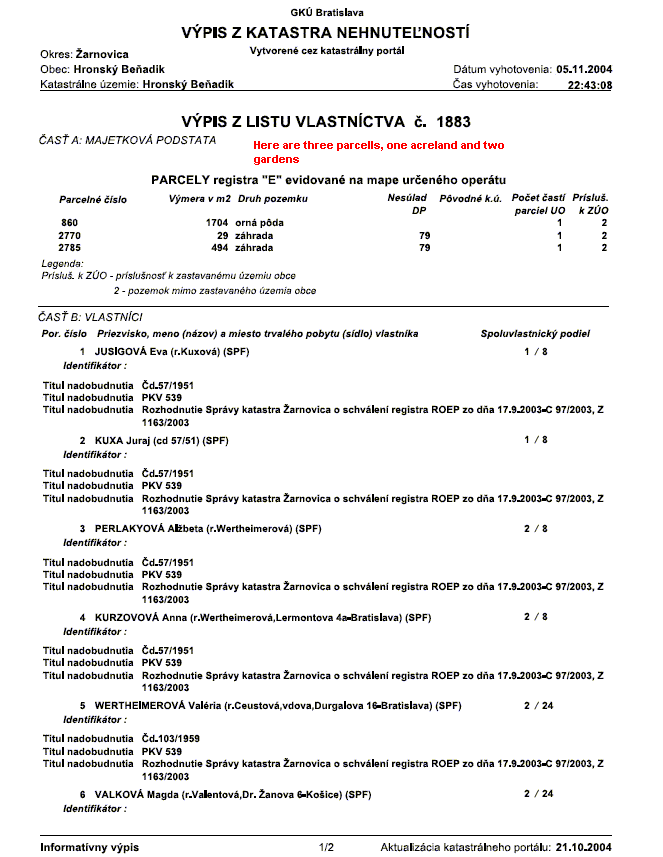
How to submit a land claim in Slovakia
The heirs of the land left by emigrants from Slovakia, which is now recorded as "unclaimed" are their grandchildren or great grandchildren. It is enough, that one of the eligible heirs submit a claim - this will put the bureaucratic machinery in movement. This one petitioner has not only to prove, that he is the heir, but he has also to show, who are the other heirs. It means, that any of the heirs can do it and all other heirs will be involved automatically. The court will inform all the heirs, that an estate has been found, where they are eligible heir. They can either accept the inheritance, or resign by written declaration. In case they resign, the court will ask theirchildren, if they want to be heirs, thus the children have resign also. If all oversee cousins would resign, then the property will go only to the Slovak heirs. Of course, the Slovak cousin can submit a claim without informing the court about American cousins and signing a testimony, that the Slovak cousin is the only one heir. This is "de jure" a fraud, but the courts in Slovakia have no means to do investigations for oversee heirs.
It would be extremely frustrating to claim land in which the expatriate heirs may have only a small fraction of ownership. The monetary value of the unclaimed land
is usually small.
CentroConsult offers professional assistance in:
- Mining of the data included in the Slovak land records for genealogy purposes;
- Identification of the unclaimed land left in Slovakia by ancestors;
- Assessment, if it is worthwhile to submit a claim
(according the Slovak law, also foreigner are eligible, the
question is, if the value of the estate is not less than the
fees);
- Filing land claims in Slovakia.
Press monitor - articles published in the Slovak Spectator
How foreigners can find their way to Slovak land (9 February 2004)In Slovakia some records of property ownership are a century out of date (9 February 2004)
Online real estate register launched (23 February 2004)
Fidesz claim rejected (26 July 2004)
Credit to Bill Tarkulich for proofreading corrections and comments
Last update: 8 January 2008
This help page is
sponsored by CentroConsult
CentroConsult offers individualized genealogy research services in Slovakia and former Austria-Hungary
CentroConsult offers individualized genealogy research services in Slovakia and former Austria-Hungary